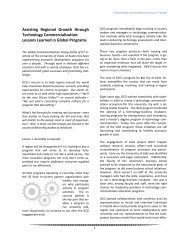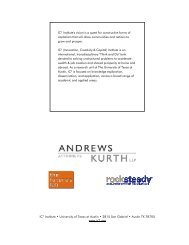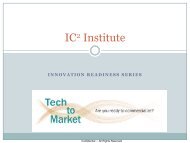“Quicklook” Assessment of Greater Adelaide's Assets & Challenges ...
“Quicklook” Assessment of Greater Adelaide's Assets & Challenges ...
“Quicklook” Assessment of Greater Adelaide's Assets & Challenges ...
You also want an ePaper? Increase the reach of your titles
YUMPU automatically turns print PDFs into web optimized ePapers that Google loves.
opportunities. South Australian research has very much been instrumental is the<br />
development <strong>of</strong> this industry having and continuing to provide the national focus<br />
on propagation, system design, feed development and nutrition, and most<br />
recently genetics. Opportunities exist for further expansion <strong>of</strong> this industry<br />
through increased production, reducing operating costs and diversifying products<br />
(eg. abalone pearls).<br />
• Suitable areas for aquaculture. Although access to sites can be difficult,<br />
aquaculture companies and local government have developed roads and vessel<br />
servicing sites in some areas. The low population level in the state means a lot<br />
<strong>of</strong> the coastline is uninhabited and is pollution free. Freshwater run<strong>of</strong>f is also<br />
mostly absent along the state coast which again results in environmentally clean<br />
waters.<br />
Weaknesses<br />
• Import about 60% compared to export 40%. (The import <strong>of</strong> the 60% is <strong>of</strong> lower<br />
quality and priced fish, however, the export is <strong>of</strong> high quality like tuna.) The<br />
weakness is in the fact that more fish is imported than exported.<br />
• Danger is that such a large portion <strong>of</strong> the sales goes to the Japanese markets,<br />
that if a hiccup in the market on a particular species <strong>of</strong> fish that they like – could<br />
cause ramifications.<br />
• Snapper farming – The three year research project was successful in generating<br />
initial interest and the development <strong>of</strong> commercial hatcheries and growout<br />
operations. It has not however gone on to bigger things because <strong>of</strong> the<br />
discovery <strong>of</strong> a potentially more economically pr<strong>of</strong>itable species for farming<br />
(yellowtail kingfish) and the effects <strong>of</strong> a number <strong>of</strong> issues that could be<br />
addressed through appropriate research if it were funded (eg. poor quality <strong>of</strong><br />
farmed as compared to wild product resulting in lower than expected market<br />
prices; need to improve production through enhanced growth, which has been<br />
shown to be achieveable through genetic selection overseas – about 14% per<br />
generation).<br />
• Aquaculture as a strategic plan. Three state based aquaculture strategic plans<br />
have been produced over the last decade and a national one is presently being<br />
completed by the National Aquaculture Council. The recently formed SA<br />
Aquaculture Council is also active in this area. The main problem has been<br />
integrating the diverse and rapidly changing needs <strong>of</strong> the various sectors <strong>of</strong> the<br />
aquaculture industry in a government environment where existing resources for<br />
new industries were very limited and new resources are largely dependent on<br />
once <strong>of</strong>f concessions, cost recovery or fee for service. A lack <strong>of</strong> consensus on<br />
direction has also been an issue between major government departments with<br />
involvement in aquaculture. Problem is that industry is developing rapidly, need<br />
cash flow, and industry requirements change rapidly – know some things like fish<br />
health is an area that needs to be targeted, but since it is not a problem right<br />
now, will wait until cash is available<br />
COMMERCIAL IN CONFIDENCE<br />
27





